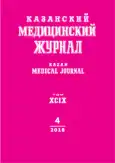Бесфиксационный способ лапароскопической паховой герниопластики
- Авторы: Тарасенко С.В.1, Богомолов А.Ю.1, Натальский А.А.1, Зайцев О.В.1, Песков О.Д.1, Кадыкова О.А.1, Мокрова А.В.1
-
Учреждения:
- Рязанский государственный медицинский университет
- Выпуск: Том 99, № 4 (2018)
- Страницы: 712-716
- Тип: Обмен клиническим опытом
- URL: https://bakhtiniada.ru/kazanmedj/article/view/9219
- DOI: https://doi.org/10.17816/KMJ2018-712
- ID: 9219
Цитировать
Полный текст
Аннотация
Цель. Сравнение непосредственных и отдалённых результатов лапароскопической паховой герниопластики с фиксацией сетчатого эндопротеза и без неё.
Методы. В исследование были включены 145 пациентов старше 18 лет обоих полов с паховыми грыжами, в том числе с рецидивными после аутогерниопластики. Пациентам выполняли трансабдоминальную преперитонеальную герниопластику с установкой сетчатого эндопротеза. Случайным образом пациенты были разделены на две группы, сравнимые по возрасту, полу и характеру грыж. В первой группе (n=71) пациентам выполнена бесфиксационная лапароскопическая герниопластика, в случае прямой паховой грыжи дополненная пластикой поперечной фасции эндопетлёй; во второй группе (n=74) - лапароскопическая герниопластика с использованием герниостеплера и/или эндокорпорального шва.
Результаты. Продолжительность хирургического вмешательства в группах сравнения достоверно не различалась (р=0,92), случаев рецидива грыжи не выявлено ни в одной из групп. У пациентов первой группы был менее выражен болевой синдром в раннем послеоперационном периоде, что выражалось в достоверно меньшей потребности в наркотических анальгетиках в пересчёте на морфин (р=0,03) и меньшей длительности пребывания в стационаре (р=0,5). Преимущества бесфиксационной лапароскопической герниопластики: (1) интенсивность болевого синдрома у больных, прооперированных этим методом, меньше чем у пациентов, прооперированных традиционным методом, и в первые 24 ч после операции (р=0,45), и на 5-е сутки (р=0,69); (2) отпадает необходимость закупки импортных устройств (герниостеплеров) и самофиксирующихся эндопротезов.
Вывод. Отдалённые и непосредственные результаты бесфиксационной лапароскопической герниопластики не уступают традиционным методам установки эндопротеза; кроме того, исследуемый метод имеет ряд преимуществ.
Ключевые слова
Полный текст
Открыть статью на сайте журналаОб авторах
Сергей Васильевич Тарасенко
Рязанский государственный медицинский университет
Автор, ответственный за переписку.
Email: lorey1983@mail.ru
г. Рязань, Россия
Алексей Юрьевич Богомолов
Рязанский государственный медицинский университет
Email: lorey1983@mail.ru
г. Рязань, Россия
Александр Анатольевич Натальский
Рязанский государственный медицинский университет
Email: lorey1983@mail.ru
г. Рязань, Россия
Олег Владимирович Зайцев
Рязанский государственный медицинский университет
Email: lorey1983@mail.ru
г. Рязань, Россия
Олег Дмитриевич Песков
Рязанский государственный медицинский университет
Email: lorey1983@mail.ru
г. Рязань, Россия
Оксана Александровна Кадыкова
Рязанский государственный медицинский университет
Email: lorey1983@mail.ru
г. Рязань, Россия
Анна Викторовна Мокрова
Рязанский государственный медицинский университет
Email: lorey1983@mail.ru
г. Рязань, Россия
Список литературы
- Фёдоров И.В., Воронин В.Н., Воронин А.В. и др. Отдалённые результаты пластики грыж собственными тканями. Казанский мед. ж. 2006; 87 (3): 225-226.
- Li W., Sun D., Sun Y. et al. The effect of transabdominal preperitoneal (TAPP) inguinal hernioplasty on chronic pain and quality of life of patients: mesh fixation versus non-fixation. Surg. Endosc. 2017; 31 (10): 4238-4243. doi: 10.1007/s00464-017-5485-1.
- Lederhuber H., Stiede F., Axer S. et al. Mesh fixation in endoscopic inguinal hernia repair: evaluation of methodology based on a systematic review of randomised clinical trials. Surg. Endosc. 2017; 31 (11): 4370-4381. doi: 10.1007/s00464-017-5509-x.
- Rosen M., Brody F., Ponsky J. et al. Recurrence after laparoscopic ventral hernia repair. Surg. Endosc. 2003; 17 (1): 123-128. doi: 10.1007/s00464-002-8813-y.
- Тарасенко С.В., Богомолов А.Ю., Зайцев О.В. и др. ERAS - современная концепция ведения хирургических больных. Собственный опыт. Наука молодых - Eruditio juvenium. 2016; (3): 67-71.
Дополнительные файлы






